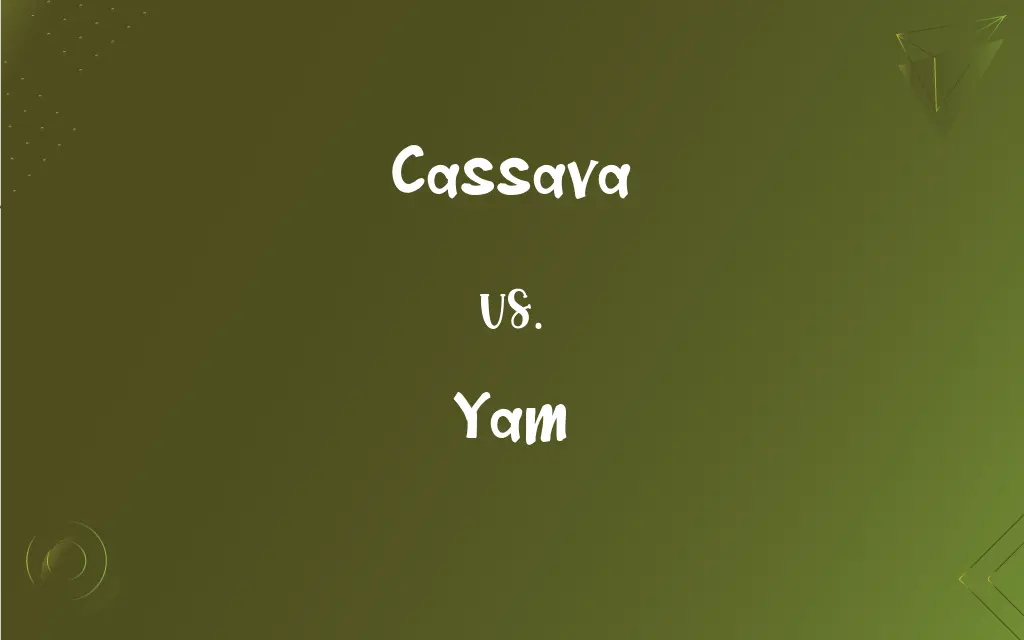Cassava vs. Yam: What's the Difference?
Edited by Harlon Moss || By Janet White || Published on August 4, 2024
Cassava is a tropical root with a starchy interior and rough skin, used in various dishes, while yams are tubers with a sweeter taste and more varied sizes and shapes.

Key Differences
Cassava, also known as manioc or yuca, is a long tuberous starchy root with a rough, brown skin and white or cream interior. Yams, in contrast, are larger tuberous roots, varying in color from white to orange and sometimes purple, with a sweeter taste than cassava.
Originating primarily from South America and Africa, cassava is a staple in many tropical diets and needs to be cooked to remove naturally occurring cyanide. Yams, predominantly found in Africa, Asia, and the Caribbean, are also a staple in many cultures and can be cooked in multiple ways, including boiling, frying, and baking.
Cassava is processed into various products like tapioca and cassava flour, used in gluten-free and grain-free cooking. Yams, with their sweeter flavor, are often used in both savory and sweet dishes, and are a source of carbohydrates and dietary fiber.
In terms of nutritional value, cassava is high in carbohydrates and calories, but low in protein, vitamins, and minerals. Yams are also rich in carbohydrates but provide more nutrients, including vitamin C, potassium, and dietary fiber.
The physical appearance of cassava is generally consistent, with a cylindrical shape and rough texture. Yams, however, come in a variety of shapes and sizes, sometimes weighing up to several pounds and having a more rounded or elongated shape.
ADVERTISEMENT
Comparison Chart
Origin
South America, Africa.
Africa, Asia, Caribbean.
Taste
Starchy and neutral.
Sweeter, varies by type.
Processing
Made into tapioca, flour.
Boiled, fried, baked.
Nutritional Value
High in carbs, low in protein.
Rich in carbs, vitamin C, fiber.
Physical Appearance
Long, cylindrical, rough skin.
Varied sizes/shapes, smoother skin.
ADVERTISEMENT
Cassava and Yam Definitions
Cassava
Cassava is a starchy tropical root vegetable.
Cassava is a key ingredient in many African dishes.
Yam
Yam comes in many varieties with different colors.
The purple yam adds vibrant color to desserts.
Cassava
It's a staple food in many tropical regions.
Cassava is often used to make a flatbread called casabe.
Yam
It is a versatile vegetable used in various cuisines.
He used yam to make a savory stew.
Cassava
Cassava requires cooking to remove toxins.
She carefully boiled the cassava to make it safe to eat.
Yam
Yams are often larger and sweeter than sweet potatoes.
She chose a large yam for her baking recipe.
Cassava
Cassava is known for its long, tuberous shape.
The cassava root can grow quite large in fertile soil.
Yam
Yam is a sweet, starchy tuber.
Yams are a popular ingredient in Thanksgiving dishes.
Cassava
It is the source of tapioca.
Tapioca pearls in bubble tea are made from cassava.
Yam
Yams are rich in nutrients like vitamin C and fiber.
Yams are a nutritious addition to her diet.
Cassava
A shrubby tropical American plant (Manihot esculenta) widely grown for its large, tuberous, starchy roots.
Yam
Any of numerous chiefly tropical vines of the genus Dioscorea, many of which have edible tuberous roots.
FAQs
Is cassava gluten-free?
Yes, cassava is naturally gluten-free.
Can you eat cassava raw?
No, cassava should not be eaten raw due to its cyanide content.
What dishes can you make with yams?
Yams can be used in stews, soups, baked goods, and fried dishes.
Are yams and sweet potatoes the same?
No, yams and sweet potatoes are different, with yams being larger and sweeter.
What is cassava commonly known as?
Cassava is also known as manioc or yuca.
What is the nutritional value of yams?
Yams are rich in carbohydrates, vitamin C, potassium, and dietary fiber.
How do you store cassava?
Store cassava in a cool, dry place and use it within a few days of purchase.
Can yams be eaten raw?
It's not recommended to eat yams raw; they are best cooked.
What climate does cassava grow in?
Cassava grows in tropical and subtropical climates.
Is yam high in calories?
Yams have moderate calories and are nutrient-dense.
Can cassava be fried?
Yes, cassava can be fried and is often served as a snack.
What is the difference in taste between cassava and yam?
Cassava is more neutral and starchy, while yams are sweeter.
Are yams good for weight loss?
Yams are nutritious but should be consumed in moderation as part of a balanced diet.
What is tapioca made from?
Tapioca is made from the starch extracted from cassava roots.
How do you cook yams?
Yams can be boiled, baked, fried, or roasted.
Can yams be used in desserts?
Yes, yams are often used in desserts, especially in Asian and African cuisines.
Can cassava be used in baking?
Yes, cassava flour is commonly used in gluten-free baking.
Do yams contain sugar?
Yams contain natural sugars, giving them a sweet taste.
How long does cassava last when stored?
Cassava can last a few days to a week when stored properly in a cool, dry place.
Is cassava safe for people with allergies?
Cassava is allergen-friendly but should be prepared properly to remove toxins.
About Author
Written by
Janet WhiteJanet White has been an esteemed writer and blogger for Difference Wiki. Holding a Master's degree in Science and Medical Journalism from the prestigious Boston University, she has consistently demonstrated her expertise and passion for her field. When she's not immersed in her work, Janet relishes her time exercising, delving into a good book, and cherishing moments with friends and family.
Edited by
Harlon MossHarlon is a seasoned quality moderator and accomplished content writer for Difference Wiki. An alumnus of the prestigious University of California, he earned his degree in Computer Science. Leveraging his academic background, Harlon brings a meticulous and informed perspective to his work, ensuring content accuracy and excellence.






































































